| |
"You need people like me. You need people like me so you can point your fuckin' fingers and say, 'That's the bad guy'. So what that make you? Good? You're not good. You just know how to hide, how to lie." |
| |
Tony Montana tells it like it is |
Can there be a remake anywhere in film history that has had the international cultural impact of Scarface? It wasn't always that way. When it opened back in 1983, it did so to mixed and sometimes hostile reviews. It was, after all, a reworking of what is rightly regarded as a noir gangster classic, one directed by none other than Howard Hawks. It was condemned for its length (it ran for almost three hours at a time when this was not the big budget Hollywood norm) and a level of drug use and violence that was widely regarded as excessive. And as for the language... Believe it or not, Brian De Palma even landed a Razzie award nomination for Worst Director.
And yet in 2003 it made #8 on Entertainment Weekly's Top 50 Cult Films, and five years later was #10 on the American Film Institute's all-time top ten American gangster films list. At the time of writing it is #147 on the IMDb's Top 250 with a user rating of 8.2/10, and has an 88% fresh score on Rotten Tomatoes. The film's central character, Cuban street punk turned Miami drug lord Tony Montana, has become one of the most impersonated characters in modern film (according to De Palma, Bruce Willis and Tom Cruise both do wicked imitations), and the line "Say hello to my little friend!" came in at #61 in the AFI's top 10 movie quotes in American cinema. Scenes have been parodied in both The Simpsons and South Park, and the film even gave birth to two video games, Scarface: The World is Yours and Scarface: Money. Power. Respect. Montana himself has been the subject of songs by The Lonely Island and rap singer Future ATL, while the film's enthusiastic adoption by hip-hop culture led to a 16-track album, Def Jam Recordings Presents Music Inspired by Scarface.

But not all of its influences are quite so worthy of celebration. On the DVD of Matteo Garrone's superb Gomorrah (in which two young wannabe gangsters act out scenes from the film), author Roberto Saviano, who wrote the meticulously researched book on which the film was based, reveals that a disturbing number of real-life Italian mobsters have modelled themselves directly on American movie gangsters and Tony Montana in particular. And Montana Management, the name of the company set up by Montana for drug money laundering, was borrowed for an identically named trust fund used for financial dodgy dealing by one Saddam Hussein, whose sons Uday and Qusay were apparently big fans of the film.
It seems unlikely that many of you will be completely unaware of what Scarface is about, but I'm obliged to provide a quick plot summary anyway. Back in 1980, the Mariel Harbour boat lift saw thousands of Cubans flee to America, a sizeable minority of whom had been freed from Cuban prisons. One of their number, small-time hoodlum Tony Montana, is processed by cynical immigration officials and shipped to a Florida holding camp known as Freedom Town, where he earns green cards for himself and his friends Manny and Angel by assassinating a former Cuban government official for wealthy drug kingpin Frank Lopez. Following a demoralising spell working at a sandwich bar, Tony's audacity earns him and his friends the chance to broker a drug deal with a Columbian group. The deal goes bad and Angel is killed, but the others escape with the drugs and the money, which Tony and Manny deliver personally to Lopez, who immediately takes Tony under his wing. But Tony has higher ambitions for himself, particularly when he claps eyes on Frank's beautiful young girlfriend Elvira.
Key elements have been adapted from Hawks' original, but in other respects the two are very different films. This, as it happens, is a very good thing. The problem with remaking any great film is that the ghost of the original tends to haunt every scene. Only when that remake rethinks or reinterprets the approach of its predecessor and becomes its own movie – Phil Kaufman's 1978 take on Invasion of the Body Snatchers is an excellent example – does it cease to be dogged by memories of what went before. In that respect it may well have helped that screenwriter Oliver Stone – yes, that Oliver Stone – wasn't a fan of the earlier film, and thus approached this version as an original work rather than a reverential update. Even so, few if any remakes diverge from the original in as dramatically as Scarface. The fifty-one year gap also provides its share of default changes, with the international cocaine trade standing in nicely for prohibition-era booze, and being a product of the 1980s, the language and violence are also a little stronger. Ah yes, the language and the violence...
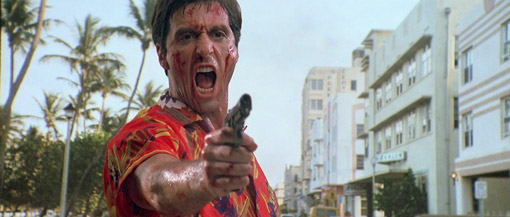
A lot has been written about those particular elements, and on the film's initial release they were the key focus of pretty much every review I read, the critical discontent summed up by Leonard Maltin, who complained that the film "wallows in excess and unpleasantness for nearly three hours, and offers no new insights except that crime doesn't pay." It's certainly fair to say that if you're not fond of swearing and prefer your violence to take place tastefully off screen, then you're going to have a problem with this particular movie. Barely a conversation goes by without the word "fuck" appearing a number of times, and once Tony discovers the wonders of cocaine, it gets considerably worse. There's even a video on YouTube that re-edits the film to tell the story entirely through that particular word's usage,* and a feature on this Blu-ray release that let's you keep track of the two-hundred and twenty-nine times it appears. To the uninitiated at least, it must thus seem absurd to suggest this is not excessive, but that's just what I'm going to do. The use of this particular word is very much part of Montana's make-up and macho posturing, and thus never feels forced or thrown in for shock value. At this very moment there are a group of builders working next door to my house, and their foreman must use the word "fuck" somewhere between five and twenty times a minute, sometimes more, all at a volume that could be heard from space. Is it necessary? No. Is it excessive? Definitely. But for better or worse, it's also a part of who that man is, and if I were watching a film that was based on his life, I'd expect the main character to swear every bit as much as the man he was based on.
It's a similar story with the film's handling of violence, which while sometimes strong even by current standards is always true to the story and setting – you won't have to look far to find evidence of the lawlessness and violence that resulted from the Miami drug trade in the 70s and 80s (Billy Corben's 2006 documentary Cocaine Cowboys is a good place to start). The gunplay may often be exhilaratingly staged, but it's never overly glamorised and is usually brutal (the use of slow motion is reserved for a couple of dramatic key moments and is never employed to prettify the battles), a crucial tool in the pursuit of power in a game whose participants are willing to risk all. It's a world in which nothing succeeds like excess, a philosophy that Tony wholeheartedly embraces, wallowing as he does in the opulent trappings of sudden and seemingly unlimited wealth.
Had the original director Sidney Lumet not left the project, Scarface would doubtless have been a very different film, and I'm not going get into a discussion over how. Stone admits to being first drawn to the project by Lumet's presence and disappointed by his departure, and despite his ambition was not yet experienced enough as a director to be allowed to helm a production of this scale. The decision to hire De Palma appears to have been based less on a track record of commercial hits – his previous project, the Antonioni-inspired Blow Out, had bombed at the box-office – than his oft-demonstrated ability to tell a story in very cinematic terms. But who could have guessed, except maybe producer Martin Bregman, that handing this story to a director primarily known for Hitchcock-inspired thrillers would produce such dynamic results?
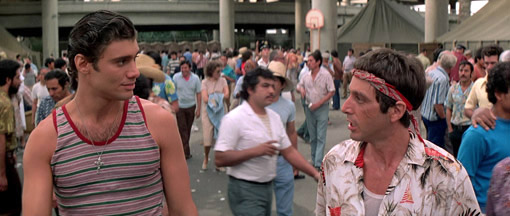
And dynamic it is. Scarface was and still is one of the most cinematically enthralling crime movies ever made. De Palma was well known for moving his camera in sometimes complex crane shots, but rarely had he done so with the purpose he repeatedly demonstrates here. There are times when the camera feels caught in Tony's magnetic aura and propelled by his energy, seeking him out and prowling around him, a faithful companion that dogs his every move. Individual shots and camera moves are repeatedly designed for their storytelling power: the pull back from a paradisical wall mural to reveal the grubby reality of Tony's first job; the shots of the children playing in back seat of the car and the bomb underneath that are juxtaposed to align us with Tony's angry discontent at his given task; the pan that moves from a ringing phone to a clock and then to Frank and plays more like a POV of Tony's thought process than what he is seeing; the montage that tells the story of his first few months in power in three economic minutes of screen time, and whose final shot provides a brief but sobering insight into Elvira's addictions and underlying unhappiness. And that's just a sample.
Specific sequences build the tension to an almost unbearable pitch and then kick like a cannon. The botched nightclub assassination attempt is a memorable example, where a kinetic blend of gunfire, crowd panic, bullet hits, locked-on-character camerawork, and the single-note drones of Giorgio Moroder's score makes the scene feel almost as apocalyptic as the climax of Carrie. But the best wind-up of all occurs early in the film in what has remained to this day its most notorious sequence. As the drug deal goes bad and Angel and Tony are led into a hotel bathroom by a Columbian drug dealer armed with a chainsaw, the camera unexpectedly drifts through the window and down to the car in which Manny and Chi Chi are waiting as backup. It's a shot that provokes mixed emotions: there's a real sense of frustration that Manny is flirting with a girl instead providing some urgently needed intervention, but this is tempered by a small sense of relief that we've been spared the horrors of what is about to unfold only a few metres away. But no sooner has the camera settled on the car than it drifts back up through the bathroom window, where knowledge of Manny's distraction adds a further layer of tension to a sequence that is terrifying enough on its own. What follows is certainly horrifying, but a lot less graphic than some have suggested, a masterclass in how suggest you saw something that in reality was shaped almost entirely through reaction shots and grisly sound effects.** It's an approach discarded in the celebrated climax, where an operatic collision of themes, story threads and furious gunplay ends in an almost superhuman refusal to lay down and die, a sequence that actor Steven Bauer nicely described as "fucking Dante's Inferno."
Nothing about Tony is theoretically likeable. He's foul-mouthed, self-centred, avaricious and merciless, and that's before he becomes addicted to cocaine, which adds rampant paranoia into the mix. But he's also honest, defiant, determined and fearless, a straight-talking underdog in a world in which honour and integrity are alien concepts, and where only the most ruthless can survive and prosper. And for all his faults, he's immensely charismatic, a gutter-born anti-hero who, in the mould of American gangsters of cinema past, we enjoy watching on screen, but wouldn't want to share space with for long in the real world.
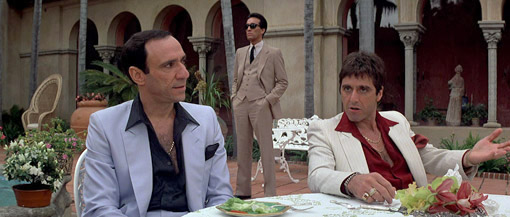
Of course, they key to selling any such character depends so much on the actor who plays him – just look at James Cagney in The Public Enemy, another tale of the rise of a young hoodlum through the gangster ranks – and here the film strikes a rare type of gold. Al Pacino, who as The Godfather's Michael Corleone epitomised the Mafiosi gangster as a cold wall of emotional restraint, plays Tony as a furious coiled spring of pent-up aggression and unbridled ambition. From the moment his is introduced in bewitching close-up, Pacino is so completely wrapped up in the character that, despite his fame and his prior body of work, I genuinely forget that I'm watching a performance. It's also a near perfect embodiment of the character as written. Consider this description of Tony's introduction from Stone's original script:
INT. OFFICE - PROCESSING HALL - AFTERNOON - A FULL CLOSEUP OF TONY MONTANA
the scar-faced one, in the young angry prime of his life. We dwell first on the scar which he likes to scratch now and then. We move to the eyes, pure in their fury. Finally we encompass the face – the face of a man about to explode – muscle, tissue, brain – a man willing to live or die and on the increment of a moment, inflict or receive either one.
As beautifully written and evocative a character description as I've ever read in a Hollywood screenplay, it could almost have been written after the film as a description of the character that unfolds in its early scenes. Just as the film's iconic poster suggests, for 170 minutes, Pacino is Scarface. Watching him again I was reminded of Nick James' review in Sight & Sound of the film adaptation of David Mamet's American Buffalo, where the key role of Teach is played by Dustin Hoffman, a part that had been played by Pacino on stage. It was James' assertion, one I have to agree with, that the talented Hoffman was miscast here, because "unlike the growling and prowling Pacino, Hoffman cannot carry off a sense of physical threat." Never, I would suggest, has that sense of physical threat been more potently realised than it is here. Every angry look and furiously intoned word feels backed up by the potential for extreme physical violence. I'm not in a position to testify to the accuracy of Pacino's Cuban accent – more knowledgeable others (including Cuban-American rap star Sen Dogg on this very disc) have praised its authenticity – but Pacino brings enough of himself to the vocal delivery to render it unique, a key aspect of what has raised Tony Montana to cult status.
Pacino may dominate but he never eclipses the consistently excellent work of a dynamite supporting cast, whose key players include Robert Loggia as Frank Lopez, a pre-Amadeus F. Murray Abraham as his shifty sidekick Omar, David Owen lookalike Paul Shenar as Bolivian drug lord Sosa, and newcomers Mary Elizabeth Mastrantonio and Michelle Pfeifer as Gina and the coldly statuesque Elvira (just watch Pfeifer in the aforementioned final shot of the success montage). Even the smallest roles have been carefully cast, from Miriam Colon as Tony's angrily disapproving mother and site favourite Mark Margolis an wonderfully named assassin Alberto The Shadow to Arnaldo Santana as bulky henchman Ernie, whose relief at not being shot provides an unexpected comic punchline to a tense pivotal scene. But special mention must go to Cuban-American newcomer Steven Bauer, who as Tony's best friend Manny always holds his own in Pacino's presence, and provides us with a genuinely likeable guy to root for when things takes a later downward turn. If only he hadn't got involved with Tony's sister...

The density of incident and character detail, coupled with a pace that never drops and intermittently kicks into hyperdrive, make the film's near 3-hour running times disappear in a blink. Actor Robert Loggia suggests this is a film of two distinct halves, with the impressionism of the first half giving way to expressionism in the second, and there's definitely something to this interpretation. The general opinion is that Tony's downfall really begins in the emotionally painful restaurant scene, where his drunken complaints about the hollow nature of success lead to a very public split with Elvira and the above-quoted monologue to the stunned restaurant patrons. But for me his doom is sealed from the moment he he gets a real taste of power, and the seeds are sewn at a far earlier stage. His relentless pursuit of the superficial trappings of wealth leaves him spiritually hollow and ultimately isolated – even his attraction to Elvira is based not on her personality or any emotional connection but how she looks when he first catches sight of her, encased in a glass elevator like a doll in a display case. As Oliver Stone states on this very disc, "Luxury corrupts far more ruthlessly than war," a concept he explores in the film's underlying criticism of unprincipled materialism and the dark side of the American Dream, which feels as relevant now as it did at the dawn of the decade in which greed ran rife.
As someone who fell in love with Scarface on its initial release (despite the fact that we attended an afternoon showing at an almost empty cinema, my friend and I were whooping out loud as the credits rolled and returned to see it again just a couple of days later), the turnaround in opinion can't help but remind me just a little of Blade Runner, that other critically maligned studio film from the early 80s that has since been elevated to cult classic status. It's one of those serendipitous films where the right director has been paired with the right actor and the right material – as Eli Roth suggests in the extra features, it showcases De Palma, Stone and Pacino at the top of their game, but does so precisely because of what each was able to inspire in the other.
Scarface was always a great-looking film (De Palma's instructions to cinematographer John A. Alonzo were to give him beautiful images into which he then would put violence), something that previous DVD releases have not really showcased, so hopes were high for this Blu-ray remaster. The results are impressive, but not spectacular, with a marked increase in detail and sometimes eye-popping colours tempered a little by what looks like traces of image enhancement that transform film grain into patterns on uncluttered areas like clear blue skies and the like. The contrast is well balanced, but does get a little aggressive in darker scenes, with picture detail sometimes sucked into the black. How much of this is down to the original film is hard to say – the light level in the sequence where Manny drives Gina home is so low that it's almost reduced to two faces floating in the dark, but that's exactly how it appears on the previous DVD, which in spite of everything, this is still vastly superior to. I can't speak for the DVD version included in the triple-play set as this was not provided for review.
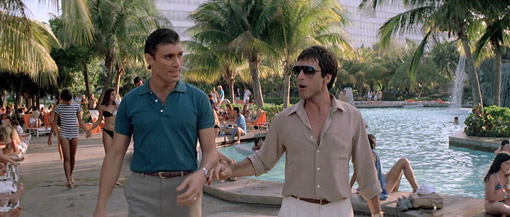
The soundtrack options offer a choice between English, Spanish and French DTS 2.0 stereo, or a brand-new English 7.1 DTS-HD Master Audio surround remix. Want to guess which one sounds the best? The clarity, range and separation on the surround track are excellent for a twenty-eight year old film, with the music and sound effects making full use of the entire surround stage, particularly for ambient effects and the Babylon Club music. The riot in Freedom Town is particularly well handled, with the general pandemonium and circling helicopters making it feel almost like we're in a war zone. The stereo 2.0 track is a little weedy by comparison, having an anaemic, almost tinny quality, although even this is superior to the acoustically flat Spanish and French tracks.
French, Spanish and English SDH subtitles are also provided.
The Scarface Phenomenon (38:34)
One of the few extras not ported over from previous DVD releases, this busy featurette looks at the film and its legacy, and includes contributions from De Palma, producer Martin Bregman, actors Steven Bauer, Robert Loggia and Richard Beltzer, filmmakers Eli Roth, Keith Gordon and Antoine Fuqua, rap artist Sen Dogg, reviewer Julia Salamon, authors Ken Tucker, Roberto Saviano and L.A. Banks, and Canadian TV hostess Jillian Babarie Reynolds. Have I missed anyone? Being a studio-approved feature, nobody has anything negative to say about the film – Saviano certainly doesn't get to repeat his stories of Italian gangsters basing themselves on Montana from the Gomorrah DVD – but the enthusiasm is genuine and the assessments of the film's qualities are generally well argued, and the supplied background detail on the production is always welcome.
The World of Tony Montana (11:38)
Assembled in the manner of an MTV special, with enough graphical game-playing to try the patience of even the more tolerant cineaste, this featurette may be the most visually annoying thing on the disc, but it does have some interesting testimony on the accuracy of the film's depiction of the 80s Miami drug scene from real life Drug Enforcement Agency officers, plus some stating the bleeding obvious from two other dudes of questionable relevance. In a particularly telling statement, one of the officers says of the period, "If you took the drug money out of Miami, the whole state would sink."
The following five features have been ported over from the 2004 2-disc Special Edition DVD release.
Deleted Scenes (22:29)
Fifteen (usually long) deleted shots from the film, some from the same scene as their immediate neighbours, all of them in their raw unedited state, usually boarded and with the call to cut included. There are several set in Freedom Town, including a very long and logistically complex mobile shot that leads Tony, Manny and Angel through busy crowds and ends on Tony walking away and singing. There are two angles of the drive to the hotel for the Columbian cocaine deal, during which Tony chastises Angel for his religious beliefs and rejects their idea of the existence of any gods. A brief shot from the mid-film power montage of Tony buying a dress for Gina is shown here with its original sound, with the shop assistant mistaking Gina for Tony's wife, highlighting the incestuous overtones of their relationship. There's some interesting stuff here, most of which has been drawn directly from Stone's script.
The Rebirth (10:08)
Bregman, De Palma, Pacino and Stone provide a detailed timeline of how the film came about, including Lumet's involvement and the reasons for his departure. Particularly interesting are the details of Stone's research – when travelling in South America he took his wife as security (he figured those he interviewed would be less suspicious of a man travelling with a woman) and drew creative strength from a potentially life-threatening encounter because it put him back in touch with the fear he experienced in the Vietnam war.
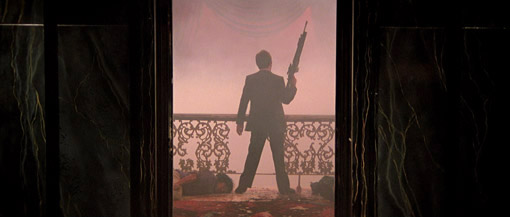
The Acting (15:05)
The casting of the key parts is discussed by the usual suspects, with Bauer providing some interesting detail on his journey from Cuban immigrant to Pacino's co-star. Cinematographer John A. Alonzo chips in with a story about how Pacino asked him to only talk to him in Spanish during the shoot, and there is plenty of praise dished out by everyone for their fellow performers.
The Creating (29:35)
Bregman, Stone, et al discuss the making of the film, and pleasingly cover different ground to The Scarface Phenomenon. Details include getting Tony's scar right, the synchronising of gun flashes to the camera shutter, the importance of humour, the helicopter hanging stunt, the initial bad reviews, the help the production received from the US Attorney's Office, and the battle to get an R rating. Giorgio Moroder chips in on the score, and Bauer recalls a telling comment made to him at an early screening by Martin Scorsese.
Scarface: The TV Version (2:48)
A series of clips comparing the original film to the sanitised one aired on American TV. A couple of the language substitutions are hilarious.
The Making of Scarface: The Video Game (12:05)
A shameless promo for the first video game that talks to a couple of those involved in its making (one of whom appears wearily image conscious) and some of the actors who provided the voices, including Robert Loggia, Michael York and James Woods, the last of whom wanted to be involved because he loved the movie.
U-Control
One of those Blu-ray gimmicks that allow for some interesting interactive features, but which prove a bit of a nightmare for plasma screen owners, as activating it places a high contrast icon on the bottom right of screen that will be there forever if you leave it on for three hours. Which is a bit of a shame, as the picture-in-picture function is very well done and a useful companion to the film. When activated, it intermittently throws up a window on the bottom right that plays content relevant to the scene in question, the gaps between which are pleasingly shot. Much of this has been drawn from the accompanying featurettes, but it also includes material that was doubtless shot for inclusion but was lost from the final cut, including an emotional response from Steven Bauer to the hostile critical reaction, Stone condemning the American incarceration of drug users as fascist, and Keith Gordon talking about the innovative nature of some the camera moves. The above-mentioned censored TV version occasionally pops up, as do sequences from the Howard Hawks version that bear a structural resemblance to their remake equivalent.
You can also use this feature to activate counters that keep track of the number of times the word "fuck" is spoken (229) and the number of gunshots fired (8509!).
If your player is internet connected then you also have access to BD-Live, a function I have yet to get remotely excited about that provides access to additional content, most of which seems designed to sell other stuff put out by this distributor.
A favourite American film from the 1980s gets a picture and sound upgrade that, while not quite as polished as I would have hoped, is still far superior to the previous DVD versions. If you have that earlier Special Edition DVD then you'll already have a good many of the extra features, but in spite of my complaints, the audio visual quality still justifies the upgrade, and if you don't have it on DVD you're onto a winner.
* http://www.youtube.com/watch?v=KANukZsWD9Q
** This sequence was cut by 25 seconds on the film's initial UK release. None of the censored material contained on-screen violence, and the cuts thus appear to be more of a reaction to the intensity of the sequence than anything you see.
|